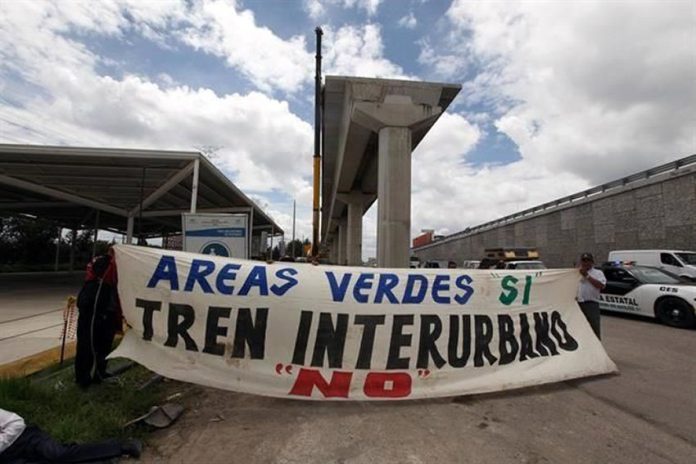A federal court has upheld a district court order granted to landowners in an outer borough of Mexico City that could place the completion of the Mexico City-Toluca train project at risk.
District court Judge Fernando Silva García granted a “definitive suspension” in February to Perla Negrete Gómez that prevents authorities from seizing 1,111 square meters of land owned by the Negrete Gómez family in Cuajimalpa.
The land abuts the Mexico City-Toluca highway at a point where it runs parallel to the toll route between the two cities.
The federal court’s confirmation this month of the “definitive suspension” is not open to appeal and will remain in force while an injunction application is processed, which according to the newspaper Reforma could take more than a year.
The Secretariat of Communications and Transportation (SCT), which is responsible for the 59-billion-peso (US $3.1-billion) project, argued that the original definitive suspension order didn’t take into account the public interest of the rail project being completed.
But the federal court rejected the secretariat’s claim, stating that the argument was insufficient to overturn the order, while also taking into consideration the complainants’ claim that proper expropriation procedures had not been followed.
The SCT had opposed that claim, contending that the land in question was expropriated by decree as part of a right of way obtained by the federal government in 1993 to build a stretch of the Mexico-City-Toluca highway.
The SCT also asserted that the Negrete Gómez family doesn’t have a valid property title and has only presented a “record of possession” issued by the president of the ejido (community land) commission.
The court’s decision is yet another setback for the infrastructure project, which has already faced delays, protests, construction problems and claims that it is unviable due to overruns.
Despite the difficulties, the SCT says the 57-kilometer project is now 82% complete and will be ready to start operations in the first quarter of 2020, with the capacity to transport 230,000 passengers daily between the México state and national capitals in just 39 minutes.
The civil engineering project is anticipated to be completed by next June, the SCT said.
But revisions of the completion date have been common in the three years since the project began. It was originally scheduled to be finished by December 2017.
An SCT statement issued yesterday made no mention of the federal court’s decision, focusing instead on the project’s progress.
“We have finished — electrified and with tracks — up to kilometer 22 and are working to conclude in the next three or four weeks up to kilometer 30,” said SCT rail development director Guillermo Nevárez.
The official added that by the third week of November “approximately, all of stretch 1 of the civil project, in other words, from Zinacantepec to the tunnels of La Marquesa will be practically finished.”
Tracks are also expected to be laid on stretch 2 — two interconnected tunnels running 180 meters beneath a mountain— in November, Nevárez said.
The third stretch of the project, totaling 17 kilometers within Mexico City limits, is only 56% complete but “it is expected that the work will progress quickly due to the use of prefabricated material,” the SCT said.
The trains that operate on the new railroad will be capable of reaching speeds up to 160 kilometers per hour and will be “completely automatic” but permanently supervised from a control center.
An engineer will be on board at all times to take control of the train in the case of an emergency, the secretariat explained.
The 39-minute service will run between terminuses at Zinacantepec, just west of Toluca in México state, and Observatorio in Mexico City.
There will be four stops in between at Pino Suárez, Tecnológico, Lerma and Santa Fe.
